Thesis by Mohamed Mahdy
Conference Presentations by Mohamed Mahdy
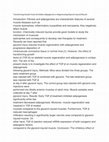
Introduction: Fibrosis and adipogenesis are characteristic features of several muscle diseases su... more Introduction: Fibrosis and adipogenesis are characteristic features of several muscle diseases such as muscle dystrophies, inflammatory myopathies and sarcopenia, they negatively affect muscle function. Chemically-induced injuries provide good models to study the mechanism of muscular dystrophies and consequently to develop new therapies for treatment. Recently we have reported that glycerol injury induced muscle regeneration with adipogenesis and progressive deposition of intramuscular connective tissue in normal mice [1]. However, the effect of transforming growth factor-β (TGF-β) on skeletal muscle regeneration and adipogenesis is unclear. Aim: The aim of the
present study is to investigate the effect of TGF-β on muscle regeneration and adipogenesis following glycerol injury. Methods: Mice were divided into three groups. The early treatment group was injected with TGF-β combined with glycerol. The late treatment group was injected with TGF-β at day 4 after glycerol injury. The control group was injected with glycerol only. Injections were performed into tibialis anterior muscles of adult mice. Muscle samples were collected at day 7 after glycerol injury. Results: Early TGF-β treatment inhibited adipogenesis significantly while late treatment decreased adipogenesis. Moreover, muscle regeneration was impaired in TGF-β treated muscles compared to the glycerol-injured muscles. Furthermore, TGF-β reduced macrophages infiltration resulting in significantly larger necrotic area compared to glycerol-injured muscle. On other hand, TGF-β injection reduced mRNA expression of both myogenic and adipogenic factors
compared to the glycerol-injured muscle. Conclusion: The inhibitory effect of TGF-β is much higher during early stages of muscle regeneration and adipogenesis.
Keywords: Adipogenesis, glycerol, muscle regeneration, TGF-β
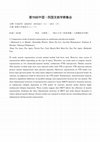
To study muscle regeneration several animal models had been used. However, time course of regener... more To study muscle regeneration several animal models had been used. However, time course of regeneration differs depending on the type of injury. Therefore, our study aims to compare muscle regeneration in two chemically-injured models, cardiotoxin (CTX) and glycerol. Tibialis anterior (TA) muscles of adult male mice were injected either with CTX or glycerol. CTX injection induced greater muscle degeneration than glycerol injection. Moreover, regeneration in CTX model was better than glycerol model. On other hand, adipocyte infiltration was detected in glycerol model. In contrast, no adipocytes could be detected in the CTX model. Furthermore, ultrastructural analysis showed a significant difference in myofiber damage and regeneration between the two models. The three dimensional structure of intramuscular connective tissue (IMCT) showed a transient increase in endomysial collagen deposition in CTX model. In contrast, glycerol model showed slight endomysial collagen deposition. These results suggest that IMCT affects the efficiency of muscle regeneration. Studying the three dimensional structure of IMCT may help clinical therapies to reduce skeletal muscle fibrosis. Future studies are required to clarify factors controlling fibrosis and adipogenesis during muscle regeneration.
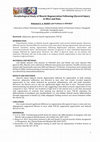
Experimental studies of skeletal muscle regeneration used several animal species. However, differ... more Experimental studies of skeletal muscle regeneration used several animal species. However, different species showed different reactions to the same injury during regeneration. The aim of the study is to compare muscle regeneration in mice and rats in response to glycerol injury. Left tibialis anterior (TA) muscles of mice and rats were injected with glycerol 50%. Muscle regeneration was evaluated at different time points post injection. Glycerol injury induced muscle degeneration followed by regeneration in both animals. However, adipocytes infiltration was detected in mice only. Our results revealed impaired regeneration in rats which indicated by persistent inflammatory cells and small myotubes. Moreover, the fibrosis area in rats was significantly higher than that in mice. TGF-β1 was localized in high level in the injured area in rats which suggested that it may have a role in suppression of regeneration and induction of fibrosis in rats.
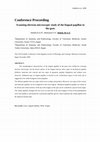
The morphological characteristics of the lingual papillae of the goat were studied by scanning el... more The morphological characteristics of the lingual papillae of the goat were studied by scanning electron microscopy. On the dorsal surface of the lingual mucosa, three types of mechanical papillae (filiform, lenticular and conical) and two types of gustatory papillae (fungiform and vallate) were observed. Additional type of lingual papillae is located on the ventrolateral aspect of the body and is suggested to be called elongated conical papillae.
The filiform papillae have two types which vary in shape and position. Moreover, two types of the conical and lenticular papillae can be recognized in the torus linguae. Abundant fungiform papillae are found on the dorsal and ventral surfaces of the tip of the tongue as this part can be considered a special sense organ. The vallate papillae arranged into two rows on each side of the torus linguae in front of the palatoglossal arch. Each papilla is surrounded by a prominent papillary groove which separates the vallate papilla from the adjacent annular pads.
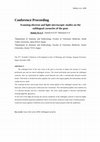
The sublingual floor of the oral cavity in the goat is crescentic in shape and consists of a rost... more The sublingual floor of the oral cavity in the goat is crescentic in shape and consists of a rostral prefrenular part and two lateral sublingual recesses. The rostral prefrenular part presents the sublingual caruncles, they are represented by slightly raised flattened area with a rostrolaterally directed serrated border. This border is divided into three papillae; the rostral is the largest papilla, the intermediate and the caudal ones are small.
The scanning electron microscopy shows that the rostral papilla of the sublingual caruncle has a wide basal part, while its apical part is trifurcated into 3 terminates. The intermediate papilla is the smallest one, it is directed laterally and has a domelike shape. The most caudal papilla is directed rostrolaterally forming fingerlike appearance.
At the level of the light microscopy the mucous membrane of the sublingual caruncle is lined by highly keratinized stratified squamous epithelium which covers dense connective tissue layer of lamina propria.
Connective tissue papillae of different sizes extend from the lamina propria within the epithelium.
Papers by Mohamed Mahdy

Cell and tissue research, Jan 12, 2018
Skeletal muscle regenerates efficiently following injuries and diseases. However, muscle regenera... more Skeletal muscle regenerates efficiently following injuries and diseases. However, muscle regeneration is compromised in several conditions by adipocyte infiltration and excessive collagen deposition. Adipocyte infiltration is a characteristic feature of sarcopenia, diabetes, cachexia, muscular dystrophies and advanced cases of Duchenne muscular dystrophy (DMD), while excessive collagen deposition is a hallmark of muscular dystrophies and severe muscle injuries, such as lacerations, contusions and strains. Muscle adipogenesis and fibrosis are major causes of muscle weakness that impairs muscle function. Therefore, it is essential to develop an appropriate injury model to understand the mechanisms of adipocyte formation and fibrosis during muscle regeneration. This will help to advance our knowledge regarding the events that occur in dystrophic muscle diseases and develop innovative therapies for such pathological conditions. To date, several experimental injury models have been used ...

Animal science journal = Nihon chikusan Gakkaiho, Jan 6, 2017
Transforming growth factor (TGF)-β1 is associated with fibrosis in many organs. Recent studies de... more Transforming growth factor (TGF)-β1 is associated with fibrosis in many organs. Recent studies demonstrated that delivery of TGF-β1 into chemically injured muscle enhances fibrosis. In this study, we investigated the effects of exogenous TGF-β1 on muscle regeneration and adipogenesis in glycerol-injured muscle of normal mice. Tibialis anterior (TA) muscles were injured by glycerol injection. TGF-β1 was either co-injected with glycerol, as an 'early treatment' group, or injected at day 4 after glycerol, as a 'late treatment' group and the TA muscles were collected at day 7 after initial injury. Myotube density was significantly lower in the early treatment group than in the glycerol-injured group (without TGF-β1 treatment). Moreover, the Oil red O-positive area was significantly smaller in the early treatment group than in the late treatment group and glycerol-injured group. Furthermore, TGF-β1 treatment increased endomysial fibrosis and induced immunostaining of α-sm...

Experimental studies of skeletal muscle regeneration used several animal species. However, differ... more Experimental studies of skeletal muscle regeneration used several animal species. However, different species showed different reactions to the same injury during regeneration. The aim of the study is to compare muscle regeneration in mice and rats in response to glycerol injury. Left tibialis anterior (TA) muscles of mice and rats were injected with glycerol 50%. Muscle regeneration was evaluated at different time points post injection. Glycerol injury induced muscle degeneration followed by regeneration in both animals. However, adipocytes infiltration was detected in mice only. Our results revealed impaired regeneration in rats which indicated by persistent inflammatory cells and small myotubes. Moreover, the fibrosis area in rats was significantly higher than that in mice. TGF-β1 was localized in high level in the injured area in rats which suggested that it may have a role in suppression of regeneration and induction of fibrosis in rats.

Acta histochemica, Jan 10, 2015
Osteoblast activating peptide (OBAP) was previously reported to be expressed in the rat stomach a... more Osteoblast activating peptide (OBAP) was previously reported to be expressed in the rat stomach and to have a vital role in osteogenesis, but its distribution in rat stomach has not been determined. Thus, the aim of the present study was to identify the cell types expressing OBAP in the rat stomach. The stomachs of twelve 10-to-11-week-old male Jc1:SD rats were used. Samples were collected for immunohistochemistry, immunoelectron microscopy and dot blot assay. Immunohistochemical investigation revealed that OBAP was distributed mainly in parietal cells without any expression in chief cells, X/A-like cells or enterochromaffin-like cells. Moreover, OBAP-immunopositive cells were observed mainly in the upper and lower parts of the gastric gland. Significantly high optical density of immunopositive cells was observed in the upper and lower gastric gland regions. The dot blot assay confirmed that OBAP is secreted by parietal cells and that it is present in the gastric gland lumen. Immuno...
Advances in Zoology and Botany, 2013
The present study was carried out to investigate the structure of the sublingual caruncles of the... more The present study was carried out to investigate the structure of the sublingual caruncles of the goat. Specimens were studied by gross anatomy, morphometery, light and scanning electron microscopy. Results show that the sublingual floor of the oral cavity consisted of a rostral prefrenular part and two lateral sublingual recesses. The sublingual caruncles had a rostrolaterally directed serrated border, this border divided into three papillae differ in shape and direction. At higher magnification, the surface of sublingual caruncle showed two patterns of microplicae. This study provides a baseline data for clinical studies, this is the first study provide detailed structure of the sublingual caruncle of goat.
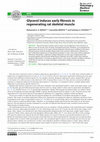
The Journal of veterinary medical science, Jan 2, 2018
Glycerol has been recently used to induce muscle adiposity in mice. However, its effects on the r... more Glycerol has been recently used to induce muscle adiposity in mice. However, its effects on the rat muscles have not been investigated previously. Therefore, we investigated the regeneration outcomes of rat muscles following glycerol-induced injury at different time points. Glycerol injection induced myofiber degeneration with extensive inflammatory infiltration on day 4 followed by appearance of regenerating myotubes on day 7 after injury without adipocyte infiltration. Meanwhile, a significant collagen deposition at early stage of regeneration that increased together with persistent inflammatory infiltration up to day 14 after injury indicates impaired regeneration. In conclusion, glycerol injury in rats is more suitable as a fibrosis-inducing model than in mice due to earlier and higher accumulation of fibrous tissue with lacking adipogenesis.

Annals of Anatomy - Anatomischer Anzeiger, 2015
In the present study, we examined muscle regeneration following two types of chemical injuries, c... more In the present study, we examined muscle regeneration following two types of chemical injuries, cardiotoxin (CTX) and glycerol, in order to compare their effect on the morphological characteristics during muscle regeneration, in addition we studied the structural changes of the intramuscular connective tissue (IMCT) during the regeneration process, by scanning electron microscopy (SEM) after digestion of the cellular elements of the muscle with sodium hydroxide. Tibialis anterior (TA) muscles of adult male mice were injected either with CTX or glycerol. Muscle degeneration was greater in the CTX-injured model than in the glycerol-injured model at day 4 post injection. Muscle regeneration started at day 7 in both the CTX and glycerol models. However, the CTX-injured model showed a higher myotube density and larger myotube diameter than the glycerol-injured model at days 10 and 14 post injection. On other hand, adipocyte infiltration was detected in the glycerol-injured model. In contrast, no adipocytes could be detected in the CTX-injured model. Furthermore, ultrastructural analysis showed a significant difference in myofiber damage and regeneration between the two models. SEM of the IMCT showed a transient increase in endomysial collagen deposition at early stages of regeneration in the CTX-injured model. In contrast, glycerol-injured model showed slight endomysial collagen deposition. Our results suggest that changes in IMCT affect the efficiency of muscle regeneration. Studying the three dimensional structure of IMCT may help clinical therapies to reduce skeletal muscle fibrosis. To our knowledge this is the first time the changes in IMCT following CTX and glycerol injury using SEM-cell maceration technique have been compared.
The small leucine-rich proteoglycans (SLRPs) are extracellular matrix molecules, they regulate co... more The small leucine-rich proteoglycans (SLRPs) are extracellular matrix molecules, they regulate collagen fibrillogenesis, interact with cytokines, affect cell growth and differentiation and play a role in tissue regeneration and wound healing. There is little information about the SLRPs expression in muscle regeneration. In the present study, we investigated skeletal muscle regeneration induced by intramuscular injection of glycerol. Regeneration of muscles was examined at various intervals corresponding to different stages of regeneration. The change in the accumulation of SLRPs during the regeneration process was evaluated by immunohistochemistry and RT-PCR. Our results showed changes in the expression patterns of different SLRPs suggesting different roles of these proteoglycans in collagen deposition. Moreover, a compensatory mechanism between decorin and biglycan may exist.
The small leucine-rich proteoglycans (SLRPs) are extracellular matrix molecules, they regulate co... more The small leucine-rich proteoglycans (SLRPs) are extracellular matrix molecules, they regulate collagen fibrillogenesis, interact with cytokines, affect cell growth and differentiation and play a role in tissue regeneration and wound healing. There is little information about the SLRPs expression in muscle regeneration. In the present study, we investigated skeletal muscle regeneration induced by intramuscular injection of glycerol. Regeneration of muscles was examined at various intervals corresponding to different stages of regeneration. The change in the accumulation of SLRPs during the regeneration process was evaluated by immunohistochemistry and RT-PCR. Our results showed changes in the expression patterns of different SLRPs suggesting different roles of these proteoglycans in collagen deposition. Moreover, a compensatory mechanism between decorin and biglycan may exist.

The current cross-sectional study was carried out to analyze the impact of COVID-19 lockdown on t... more The current cross-sectional study was carried out to analyze the impact of COVID-19 lockdown on the academic performance of veterinary medical students and researchers. An online google form questionnaire was used to invite veterinary students and researchers to answer the questionnaire. A total of 807 participants were from 86 different countries answered the questionnaire with an overall response rate of 94.1%. The participants were 50.1% males and 49.9% females. The age of participants ranged from 17 to 51 years, and the majority of them (85.0%) were undergraduate students while postgraduate students comprised 15.0%. The data showed that the COVID-19 pandemic lockdown affected the academic performance of most participants (96.5%) with varying degrees. The mean evaluation scores for the online education, in general, was 4.9 ± 2.4 while that for the practical parts was 3.7± 2.6. About 60.7% of participants evaluated the online learning in general with 1-5 of 10 points, while 77.9% ...
A novel coronavirus has been reported as the causative pathogen of the Coronavirus disease 2019 (... more A novel coronavirus has been reported as the causative pathogen of the Coronavirus disease 2019 (COVID-19) outbreak Wuhan city, Hubei Province, China in December 2019. Due to the rapid spreading of COVID-19 worldwide, it has been announced as a pandemic by the World Health Organization (WHO). Hospitalized patients in Wuhan are associated with the Huanan seafood wholesale market where live animals, such as poultry, bats, snakes, frogs, rabbits, marmots, and hedgehogs are sold in that market which suggests possible zoonotic infection. Therefore, it is essential to identify the potential animal reservoir, and the possibility of infection for other animal species. This short review aims to provide an overview of the relation between SARS‐CoV‐2 and animals.


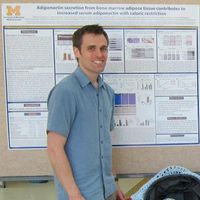




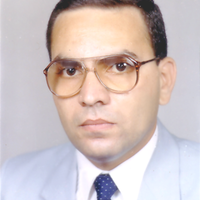



Uploads
Thesis by Mohamed Mahdy
Conference Presentations by Mohamed Mahdy
present study is to investigate the effect of TGF-β on muscle regeneration and adipogenesis following glycerol injury. Methods: Mice were divided into three groups. The early treatment group was injected with TGF-β combined with glycerol. The late treatment group was injected with TGF-β at day 4 after glycerol injury. The control group was injected with glycerol only. Injections were performed into tibialis anterior muscles of adult mice. Muscle samples were collected at day 7 after glycerol injury. Results: Early TGF-β treatment inhibited adipogenesis significantly while late treatment decreased adipogenesis. Moreover, muscle regeneration was impaired in TGF-β treated muscles compared to the glycerol-injured muscles. Furthermore, TGF-β reduced macrophages infiltration resulting in significantly larger necrotic area compared to glycerol-injured muscle. On other hand, TGF-β injection reduced mRNA expression of both myogenic and adipogenic factors
compared to the glycerol-injured muscle. Conclusion: The inhibitory effect of TGF-β is much higher during early stages of muscle regeneration and adipogenesis.
Keywords: Adipogenesis, glycerol, muscle regeneration, TGF-β
The filiform papillae have two types which vary in shape and position. Moreover, two types of the conical and lenticular papillae can be recognized in the torus linguae. Abundant fungiform papillae are found on the dorsal and ventral surfaces of the tip of the tongue as this part can be considered a special sense organ. The vallate papillae arranged into two rows on each side of the torus linguae in front of the palatoglossal arch. Each papilla is surrounded by a prominent papillary groove which separates the vallate papilla from the adjacent annular pads.
The scanning electron microscopy shows that the rostral papilla of the sublingual caruncle has a wide basal part, while its apical part is trifurcated into 3 terminates. The intermediate papilla is the smallest one, it is directed laterally and has a domelike shape. The most caudal papilla is directed rostrolaterally forming fingerlike appearance.
At the level of the light microscopy the mucous membrane of the sublingual caruncle is lined by highly keratinized stratified squamous epithelium which covers dense connective tissue layer of lamina propria.
Connective tissue papillae of different sizes extend from the lamina propria within the epithelium.
Papers by Mohamed Mahdy
present study is to investigate the effect of TGF-β on muscle regeneration and adipogenesis following glycerol injury. Methods: Mice were divided into three groups. The early treatment group was injected with TGF-β combined with glycerol. The late treatment group was injected with TGF-β at day 4 after glycerol injury. The control group was injected with glycerol only. Injections were performed into tibialis anterior muscles of adult mice. Muscle samples were collected at day 7 after glycerol injury. Results: Early TGF-β treatment inhibited adipogenesis significantly while late treatment decreased adipogenesis. Moreover, muscle regeneration was impaired in TGF-β treated muscles compared to the glycerol-injured muscles. Furthermore, TGF-β reduced macrophages infiltration resulting in significantly larger necrotic area compared to glycerol-injured muscle. On other hand, TGF-β injection reduced mRNA expression of both myogenic and adipogenic factors
compared to the glycerol-injured muscle. Conclusion: The inhibitory effect of TGF-β is much higher during early stages of muscle regeneration and adipogenesis.
Keywords: Adipogenesis, glycerol, muscle regeneration, TGF-β
The filiform papillae have two types which vary in shape and position. Moreover, two types of the conical and lenticular papillae can be recognized in the torus linguae. Abundant fungiform papillae are found on the dorsal and ventral surfaces of the tip of the tongue as this part can be considered a special sense organ. The vallate papillae arranged into two rows on each side of the torus linguae in front of the palatoglossal arch. Each papilla is surrounded by a prominent papillary groove which separates the vallate papilla from the adjacent annular pads.
The scanning electron microscopy shows that the rostral papilla of the sublingual caruncle has a wide basal part, while its apical part is trifurcated into 3 terminates. The intermediate papilla is the smallest one, it is directed laterally and has a domelike shape. The most caudal papilla is directed rostrolaterally forming fingerlike appearance.
At the level of the light microscopy the mucous membrane of the sublingual caruncle is lined by highly keratinized stratified squamous epithelium which covers dense connective tissue layer of lamina propria.
Connective tissue papillae of different sizes extend from the lamina propria within the epithelium.
Tibialis anterior (TA) muscles of adult male mice were injected either with CTX or glycerol. Muscle degeneration was greater in the CTX-injured model than in the glycerol-injured model at day 4 post injection. Muscle regeneration started at day 7 in both the CTX and glycerol models. However, the CTX-injured model showed a higher myotube density and larger myotube diameter than the glycerol-injured model at days 10 and 14 post injection. On other hand, adipocyte infiltration was detected in the glycerol-injured model. In contrast, no adipocytes could be detected in the CTX-injured model. Furthermore, ultrastructural analysis showed a significant difference in myofiber damage and regeneration between the two models.
SEM of the IMCT showed a transient increase in endomysial collagen deposition at early stages of regeneration in the CTX-injured model. In contrast, glycerol-injured model showed slight endomysial collagen deposition. Our results suggest that changes in IMCT affect the efficiency of muscle regeneration. Studying the three dimensional structure of IMCT may help clinical therapies to reduce skeletal muscle fibrosis. To our knowledge this is the first time the changes in IMCT following CTX and glycerol injury using SEM-cell maceration technique have been compared. Hsiao Yin Lei